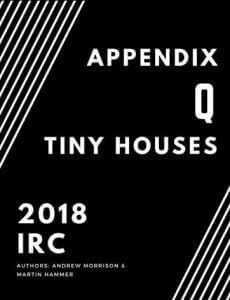The International Residential Code (IRC) is a comprehensive model building code for residential buildings developed by the International Code Council (ICC). It sets out the minimum requirements for the design and construction of one- and two-family dwellings using prescriptive provisions for building, plumbing, mechanical, fuel, gas, energy, and electrical systems.
Appendix Q is a model building code for foundation-based AND movable tiny houses, providing building safety standards for houses that are 400 square feet and under.
It relaxes various requirement in the main body of the IRC. Specifically, the Appendix Q addresses the issues related to safety and maximizing efficient design of tiny house. Attention is specifically given to features such as compact stairs, including handrails and headroom, ladders, reduced ceiling heights in lofts and guard and emergency escape and rescue opening requirements of lofts.
Report Summary
Although the IRC is a model code, each state adopts it differently. While some states adopt the code in its entirety, others choose to select parts that they like and use them to augment their state code. In some states, the adoption process is managed at the local city or county level, while in others, it is a statewide adoption process.
It is important to note that a code appendix is not automatically adopted along with the rest of the code, and its adoption may vary by state or municipality. Appendix AQ, in particular, is a model building code that provides building safety standards for both foundation-based and movable tiny houses that are 400 square feet and under.
This code appendix addresses various issues related to safety and efficient design of tiny homes, which is especially important for such small structures. It allows for compact stairs, including handrails and headroom, ladders, reduced ceiling heights in lofts, and guard and emergency escape and rescue opening requirements of lofts. Appendix AQ provides a pathway for tiny homes to be allowed as primary residences or accessory dwellings units through local zoning.
Adoption of Appendix AQ into the residential building code is up to each state and/or municipality. When adopted, it can encourage local zoning jurisdictions to be more open to the idea of tiny homes as primary residences or accessory dwelling units because they have an ICC-approved code to build those types of dwellings.
In conclusion, the International Residential Code, along with its appendices, serves as an essential guide for safe and efficient residential construction. The adoption of Appendix AQ for tiny homes can promote more sustainable, affordable, and flexible housing options in communities across the US.
2026 Events to be Announced Soon!
Join the leading companies and professionals from across the offsite construction industry at each of this year's Offsite Construction Network events. With summits and expos taking place across North America in 2026, it's never been easier to connect with and learn from offsite construction manufacturers, designers, builders, and suppliers from the United States and Canada.
Subscribe today to get the latest updates on future events from the Offsite Construction Network.

